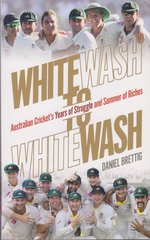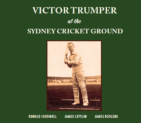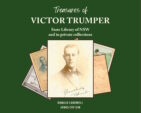Whitewash to Whitewash
Archie Mac |Published: 2015
Pages: 306
Author: Brettig, Daniel
Publisher: Penguin Viking
Rating: 4 stars

You read all the articles, watch the sports shows and think you have your finger on the pulse of Australian cricket, until you read a book like Whitewash to Whitewash. Then you realise you had half the story and most of that was half truths and innuendo.
Daniel Brettig, appears to have interviewed everyone associated within the Australian cricket family from 2007 to 2014. More impressive, than the obvious thorough research, is that Brettig has managed to solicit honest insightful answers from all and sundry, including an interview with the previous reticent Damien Martyn.
It is this honesty that provides real insight into the Australian team and the machinations between the players, coaching staff and administrators during this period. You will find by the end of the book that you have more understanding for Clarke’s plight, more respect for Ponting and perhaps less affinity for Watson’s attitude.
From 2007 to 2014 the Australian cricket side oscillated between world beaters and easy beats. The most frustrating part of this inconsistency was the poor Ashes performances and when you read Brettig’s book the Aussie failures will make more sense. Infighting and instability at all levels of the game are clear.
Brettig is not afraid to express his own opinions as to the malaise of Australian cricket during the period covered. Some of his claims include the Australian team playing their best cricket when behaving as the ‘ugly Australians’. That is playing on the edge, with copious sledging and in your face bravado. It will be a disappointment to many cricket fans if this is indeed the case but recent results suggest the ‘ugly Aussies’ are here to stay.
The book also raises other concerns with the priorities of CA (Cricket Australia) certainly questionable. The decision to direct Hussey to stay in South Africa and complete the Champions League rather then fly to India to prepare for a Test series. Hussey was furious with the direction but complied. Hussey comes across as quite a different person to the reputation perpetrated as ‘Mr Cricket’; sometimes obsequious and at other times assertive. During one summer he would say ‘stuff you Michael Slater’ each time he tapped his bat, after Slater had called for Hussey’s axing from the Australian team.
The amount of information and controversy packed into Whitewash to Whitewash, could result in the longest of reviews. It will suffice to inform that all of the key moments from 2007 to 2014 are covered. Monkey Gate, the physical clash between Clarke and Katich in the Aussie change room, the homework fiasco, Warner’s punching of Joe Root and the demise of Mickey Arthur.
There are also other previously unknown stories such as Matthew Hayden’s attempt to block Clarke’s appointment as Test captain and the botched farewell to Hussey.
This is a fine read and will entertain every cricket fan whether Australian or not. With great production values and quality writing it will not disappoint. Perhaps the only minor criticism is the lack of an index, although even this appears deliberate as author Daniel Brettig explained when he kindly agreed to an interview.
- I noticed on occasion you did not name players; as in ‘one player reported……..’ how did you decide when to name a source and when not to?
This was a matter of using my judgment. I wanted to write frankly and truthfully without unduly upsetting. Sometimes that means keeping identities confidential. I also reached an agreement with Cricket Australia that current staff/players I interviewed would not be quoted directly, for similar reasons. Hence the use of secondary sources for quotes from the likes of James Sutherland and Michael Clarke.
- Were there many discoveries/facts that you learned that did not make the book, due to their nature?
A few, but I am content that I’ve told as close to the fully story as was possible.
- Were these left out for legal reasons or for other concerns?
Legal issues come into it, but so do relationships and allowing individuals to carry on with their jobs.
- Were there many people who refused to speak with you, and can you provide any names?
The one who I will say did not was Simon Katich, who respectfully declined several requests – I can understand why, there was probably a fair amount of territory he’d rather not go back over. Readers can work out for themselves who the others were if they read the book closely enough!
- Was there a reason you did not include an index?
Yes. I love indexes but I also know that they can be an excuse not to read a book as a whole and just look for the supposed “juicy bits”. My strong preference was for the book to be read in its entirety and judgments/conclusions drawn from the whole.
- Are you expecting any fallout from your book?
As I’ve quoted Gideon Haigh in the preface, in a project of this kind it is impossible to please everybody, and more often than not an accurate account will leave a few quibbles on all sides. I hope Australian cricket is big, old and ugly enough to appreciate that I didn’t look back on things with rose-tinted glasses.
- Did you find many of your ideas/understandings of the events you covered changed after research? Examples?
I had a much better understanding of numerous relationships within Australian cricket – Shane Warne and James Sutherland for example. I was also better able to understand how and why off-field decisions had on-field impacts and vice versa. It was an illuminating experience.
- In a similar vein did you misjudge anyone, as in thought them in a better or worst light after writing the book? Examples?
I don’t think I outright misjudged – one of the fundamentals of the way I work is that if I have a preconceived view of someone I try to get to know them or people who know them better, so I can put that to one side. I will say that the outlooks and attitudes of the two selection chairmen CA had during the period intrigued me. I don’t think Andrew Hilditch or John Inverarity ever quite articulated what they were trying to do in a way the public (or in some cases the players) understood, but having spoken to many of the selectors involved I think I’ve got some idea of their philosophical differences now.
- And finally, the ubiquitous question; do you have any future projects in the pipeline?
A couple of things in mind but it will be a little while before I get to them. This book came about partly because in 2014 I had that most valuable and rare commodity – time!






Leave a comment